|
Is it possible that, for Wuzhen’s 7th annual International Theatre Festival, the sky was more blue than before? The water in the network of canals clearer, and the open boats more picturesque? Were even the large flagstone alleyways a warmer shade of gold, and the geraniums, begonias, and mystery flowers that line the alleys, did each sport more blooms? The outdoor shows—clowning, robotics, dance, new plays—seemed ever more charming as I made happy haste past them to an event, discussion, or show.
The theatre is a noble art form. We enter a space as strangers, and leave having shared a world. Whether a show is successful or not, or strikes everyone the same way, the sharing is a goal in itself, is healing, even indispensable in a political climate so troubling, and with news and social media so fragmenting and divisive.
At the Wuzhen Festival, the flag of the theatre’s nobility flies especially high: theatre artists and audience members converge from different soil and air, from separate lives and various languages, riven by dangerous narratives. The theatre allows everyone to slow down, feel and dream with others, all speaking the language of the theatre.
Thinking of all this now takes on poignancy: as a precautionary measure against the coronavirus, theatres across China have been closed since January. Aside from scotching the shows themselves, closures have scuttled the theatres’ conferences, talks, and a multitude of other activities that bring people together and support the theatres’ work. Indeed, these closings have put the kibosh on all places where people gather for entertainment and recreation—movie theatres, major tourist magnets, museums, concerts, parks—and this includes the town of Wuzhen itself. In Shanghai, photos have also been showing train stations and once-jammed traffic intersections eerily empty. Firsthand reports describe restaurants and other small businesses taking a hit with people hunkering down in their homes, and supermarkets stripped of food. Chinese citizens and residents who were outside of China were initially blocked from
returning, and now sign a paper promising to stay indoors and take their temperatures every day.
No doubt this is all temporary, the closed will open, the shuttered will come forth. The theatres will light up and the festivals rise. Maybe the scare will have subsided when you read this. In the meantime, I spotted this plea on social media, from Beijing:
- My dear international colleagues, all the theaters will be closed in China for at least all of February, maybe March and into April. We are encouraged to stay home to prevent ourselves from being infected with the coronavirus. As a result, a great number of us who are performing arts administrators have lost our incomes.
If you have any short-term research project, or if you happen to know anyone interested in our consulting regarding China’s performing arts ecology, strategies for entering its markets and so on, we'd like to offer our expertise. Thank you for your great help.
*
The Theme for the 2019 Festival was Emerge. There were 28 shows that therewith emerged, and there were many important shows I couldn’t see. I missed the white-knuckle Emerging Artists new play competition! Georg Kaiser’s Morn to Midnight was done by one of my favorite directors in China, Chen Minghao. Taking its cue from the title, the show was performed midnight-to-morn-ish: 1:30 a.m. to 6:30 a.m., really kinda just for the helluvit. I heard there was some good-natured chaos while they were devising at the last minute how to fill five hours, but I also heard it ended up terrific.
I also missed The Tree by Eugenio Barba, founder-director of Denmark’s legendary Odin Teatret. Yi Liming, China’s stage designer-director brought his take on Waiting for Godot. I was sorry to miss A Brief History of Human Evolution, by Li Jianjun. A few years ago Li brought a show whose promotional materials had made it sound like a children’s show, but which was actually a Robert-Wilson-type-of-slooow series of mystifying tableaus; families and almost everyone else left in droves. Li refers back to this as controversial exploration of theatre aesthetics. In any event, I was impressed that the Festival had invited him back, and suspected I might see something fine. And there were more… But alas, one person can only be in four or five places at once.
*
Three Sisters
Written by Anton Chekhov
Directed by Yury Butusov
St. Petersburg Lensoviet Academic Theatre. Russia
A few years ago, at the Dialogues public discussions series, a Lithuanian critic told us that European audiences expect productions from the dramatic canon to be de-constructed, altered, seen through a “postdramatic” lens, fragmentary. This four-and-a-half hour Three Sisters from Russia obliged by systematically inverting the expectations of audience members who knew the play, or even of those seeing the famous play for the first time. The scenes from the original text were played in a scrambled order, and some played several times. The three provincial sisters dressed as Bad Girls—a mélange of boots, Alice Cooper makeup, tutu, bikini, cigarette, booze, gun, and so on; brother Andrei’s humiliating wife was instead a loving sex kitten. Quiet scenes were shouted at antagonistic decibels (this was especially annoying because I had taught a voice workshop at their school); intimate scenes
were played with actors at opposite ends of the stage, facing the audience. Rather than ending once, it ended multiple times—although the show, already having had its say, was already overly long and the audience applauded expectantly after the first ending.
An evocative image: Chekhov’s Three Sisters has three dovetailing monologues at the end, fervent and forceful even in translation. Here, one sister, wearing a black bustier cocktail dress, stood at what would have been a microphone if there hadn’t instead been a light bulb on the stand, and prepared to speak. But the words never came. She thought, and made her thinking visible through expressive, expansive gestures. Without a sound, it was striking and oddly articulate. As if the purpose of the show were to kill the show, to kill language itself, and this moment was its crowning success. In his Dialogue session, director Butusov insisted: "We are creators, just like [playwrights like Chekhov]. We are equal in theater." But I was not so sure. When a non-theatre colleague of mine said he was glad that he’d finally seen Chekhov’s Three Sisters, I felt a pang.
However, in spite of itself, the show held one absolute revelation for me: I understood Andrei. I saw how deeply the sisters depended on their brother to be a success as a professor after their father died—he, the only man left in the family and the apple of their collective eyes. His playing the violin had let them feel cultured. His success would perhaps have taken them out of the provinces, or at least have given their country life meaning. Instead, he skidded off the road his sisters had planned for his life, leaving the household bereft of a male figure or pride. An image I can’t forget: Andrei had grown grossly fat until, in a moment of grief, his shirt opened and he pulled out sheet after crumpled sheet of paper, tossing them in the air, divesting himself of the years of academic degradation, of having failed his sisters. Image: his love for his wife was so great that he fondly, paternally cared for the
baby she’d had with a cuckolding mucky-muck in town. Another: he was a shadow behind a screen, his sisters sat in a row in front of it. He was telling them about himself, but the sisters had simply given up on him and left one by one; he came out from behind the screen and realized he’d been talking to empty chairs. One more: he sat at an old piano, a relic of a former family life, with three dolls tenderly propped up on it, his love for his sisters keen, palpable, heart-breaking. And here the voice of the actor took mellifluous wing, and Chekhov’s language came alive in all its troubled beauty, giving us a glimpse of what the production could have been if the talented actors had been given a chance. If this Three Sisters had been called One Brother, I would have been all in.
*
Frankenstein: Paradise Lost in Darkness
Based on Frankenstein by Mary Shelley
Directed by Ding Yiteng. China
This production was a testament to how much a written play transforms to become a full production in front of audiences. I say that because I was the Script Advisor for this production over a 20-month period, working on it in California, and could never have predicted the resulting production I saw in Wuzhen.
For the script I worked on, the director had created a mosaic of far-flung selections—from drama, poetry, literature, film, and song lyrics of multiple cultures and languages; from the ancient world to ours; from East to West; from Sophocles and Khalil Gibran to Lou Reed and David Lynch—that served as building blocks to tell a courageous, harrowing story of inter-generational secrets endured and revealed, of wrongdoing and redemption.
When a young mother and her small daughter were homeless, the desperate mother had made a devil’s bargain: in return for food and shelter, she re-married and now allows her husband to routinely sexually abuse her daughter, Wei Duo. The girl, already traumatized by having witnessed her father’s death in a motorcycle accident, is now further traumatized, and when she tries to form a relationship with a sweetheart, he also dies in an accident. Wei-duo sinks into a kind of emotional coma, only occasionally called forth by a nursery rhyme her mother recites for her.
Evil Angels, Mephistopheles-like, get Wei-Duo to trade her soul for her sweetheart’s return to life, but he returns from the dead as a devouring Monster (played by director Ding). Gradually, when we’re not looking and think we know where our sympathies should lie, all the roles begin to shift: the sweet Wei-Duo learns to kill and to enjoy killing, the Monster becomes civilized, and the abusive father turns out to have been grossly abused by his own grandmother, warping his loving nature. Wei-Duo, seeing the sorry arc of her young life, and her role in perpetuating the cycle of violence, kills herself; the sweetheart-Monster, after messages of hope and forgiveness, follows her back to death.
As spectators, we expected to observe Wei-Duo’s coma-like nightmare—her there, us here—but instead the show unfolded into a horrific nightmare that we fully inhabited. Wei-duo finally emerged from her shock like a skinned animal, all nerves exposed, raw and roaring. We thought we were just watching her, but in fact, as she finally came apart under the weight of her anguish and psychic havoc, we became her. How this happened is a secret in the directorial mind of wunderkind Ding—2018 winner of the “Best Young Director of China” award—but a secret he works to share through the “New Codification” workshops he teaches internationally, melding various classical Asian forms with Western ones, creating an original mode of performance.
This is “total theatre,” “theatre of synthesis,” the “total work of art” promised by the term gesamtkuntswerk; one critic said Ding’s work was what Artaud meant by his Theatre of Cruelty. My script was a component, folded organically into the whole: each member of the acting ensemble, beautifully trained, performed with skill, nuance and humor; the costumes supported the story to an unusual degree; even the tech crew showed special dedication. The raked set wasn’t the only design possible, but it served, and the lights performed complex tasks. The sitar and pipa player added to the overall texture of the piece. Never a fan of music “soundtracks” to bolster onstage action, the one used here was far too loud, forcing the actors to shout for the last part of the show.
There was quite a lot of weeping in the audience, so the show clearly touched something difficult and unspoken. Not every show can say that it is necessary.
*
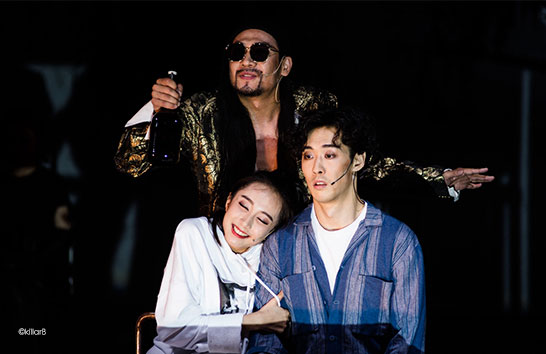
Sun and Temple
Meng Jinghui Theatre Studio. China
Satisfying! Wonderfully conceived, directed, designed and performed!
This was a quintessential production from one strain of director Meng Jinghui’s work—a major play from the modern Western canon, translated into a rock ‘n roll idiom, with the musicians playing on stage, or moving between the band and playing dramatic roles with rock-band-leader type aplomb.
Sun and Temple, Meng’s title for one of Brecht’s best comedies (1940), screams for this treatment. Brecht’s Puntila, a wealthy Finnish landowner and outsized, bacchanalian figure with an alcohol problem, is perfectly translated into an original rock ‘n roll great with over-the-top antics. Puntila roams around drunk, promising lucrative work to those for whom “blinking” and “doing nothing” are job skills, offering marriage to the widow and the spinster, and happiness to his daughter with his handsome valet… until he sobers up and reverses himself on every count. Now he is firing the needy, jilting the loveless, and marrying his daughter to an incompatible diplomat. In this society, as in our own, the rich can afford outrageous shenanigans like these, while everyone else has to endure them.
But this was much more than a production with a lot of Bad Behavior in broad strokes, noisy and busy and very funny. There was still a lot of room given to complexity in the characters and their relationships. And isn’t this always the way with Brecht? For all his purported wish to distance his audiences from the story—to “alienate” them to keep them from wallowing in sentiment, to keep them clear-headed—in the end he is also a great ham in love with everything theatrical.
And it’s in this subtle way that Meng most carries out the thrust of Brecht’s ideas. After all the flung gestures and riotous conduct, we see that Puntila (Lv Jing) loves his daughter deeply and counts on her companionship. His daughter, Eva (Luo Huan), for all her flouncing, pouting, and posing, is growing up confused by her father’s example and is genuinely trying to figure out how to be close to someone. That “someone” is the valet, Matti (Zhang Yicheng), who has no romantic feeling for Eva but who feels a brotherly responsibility for her. He also feels loyalty to and affection for his lunatic boss, while recognizing their poor man/rich man dynamic and wanting no part of it. It would be naïve not to notice that Brecht is dealing here with matters of class struggle and political systems that are in question in our time, but this was far
from overt beyond the upstairs-downstairs reality we all recognize depicted in the arts and in our own societies. Puntila may be master of much but he is not master of himself; Matti has nothing but mastery of himself. When Matti finally leaves at the end, we cheer him on for breaking free. Puntila and Eva will be helpless, with all their wealth, without Matti.
Between the performance and the audience, there was a deep, living border on the floor that stood in for the lands the rich Puntila lords it over—an inspired collection of what seemed to be soil, enormous living bulbs with their roots exposed, endless piles of potatoes—all natural objects in earth tones, and reminding us: for some people, the land is to own, and for others the land is to revere.
*
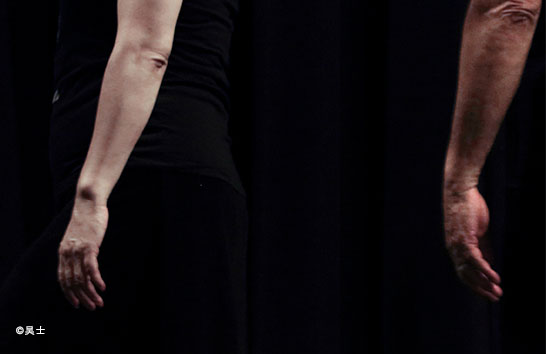
When My Cue Comes, Call Me, and I Will Answer
Director-Choreographer: Wang Mengfan. China
Seated early, I was there in time to see two charismatic older people enter and take their seats. They radiated dignity and presence just sitting, waiting for the show to begin.
But they were the show. Cao Zhiguang, 81, and Liu Guilin, 58, were dancers retired from China’s great Central Ballet. Cao had been trained in the 1950s by an eminent Soviet dancer and choreographer, Pyotr Andreyevich Gusev. Cao went on to an illustrious career, dancing in some of the celebrated revolutionary ballets of the day, including the epitome of the form, “Red Detachment of Women.” Liu achieved entrance to the Central Ballet in 1979, danced many great roles and headed troupes that also traveled abroad.
The premise of the show is that the dancers are too old to dance as they used to, and have nothing left of their dancing days but muscle memory. The director, 30, has them “release tensions” to make peace with not having good balance anymore, and with making random, inane movements that don’t require any skill: Cao’s walking or lifting an arm and, most annoying, Liu’s prolonged alternating between taking a few steps and then bending over to swing her long hair.
Of course all this was intended to honor Cao and Liu, but I thought it was insulting anyway. It’s nice that the two of them were asked by young people to do a project with a “new” sensibility, instead of their just being forgotten. But asking two important dancers to do activities a pre-schooler could do is just condescending. When they were finally allowed to dance a brief section of a classical ballet from their pasts, the audience took a collective gasp at their loveliness. So much for the pathos of “ageing.”
My favorite part was when Cao walked along the edge of the audience, peering into the seats, pointedly showing everyone his ballet hands as he moved them: now wrists, now fingers, turning them this way and that, showing their different characteristics, possibilities, histories. There wasn’t a person in the room who could have done what he was doing, and he seemed aware that if he didn’t show them now, they might well never see it, never know what had been lost, training and tastes having changed.
Cao was sitting as I left the theatre, so I went and held his hands for a bit.
The next morning someone told me that this show is one section of a much longer piece still being developed. So I can hope it gets better.
*
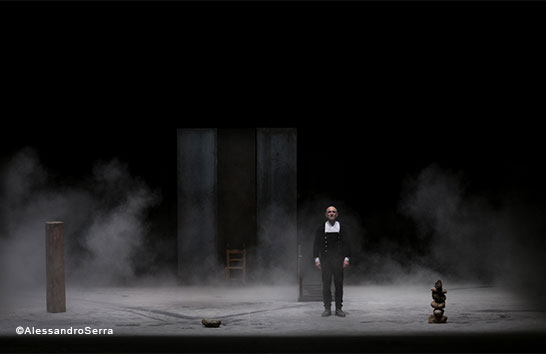
Macbettu
Based on the play by William Shakespeare
Directed and designed by Alessandro Serra
Sardegna Teatro of Sardinia. Italy
This was a kind of meditation on the vulnerability of the powerful, communicated in a series of sculptural stage images or simple actions that made intuitive rather than literal sense. An 11th century story that took place in a remote location, here only suggested in elementals: metal, stone, dust, darkness. Black and dark gray costumes on black and dark gray set, action coming out of the dark. Tall, narrow, dark gray metal panels served as a backdrop and then transformed into long tables for the banquet. Then disappeared.
The director’s inspiration was the Barbagia region of Sardinia, which still has ancient carnivals featuring masks, chants, bells, and dance. From Shakespeare, he drew the idea that a show is a popular entertainment: the witches served this purpose mirthlessly, clambering over things, dancing, appearing upside down under the long tables. Also from Shakespeare’s time came the idea of an all-male cast: Lady M. was an actor a head taller than the rest of the cast, with long hair and beard; as guests, the men snuffled on the floor on all fours, like pigs. Stones knocked on metal, like hobnail boots sounding in a stone hallway, or someone insisting on entry; “compositions” organized the echoing sounds of stone on stone; someone walked slowly crunching over a table covered with something like flat bread or plaster; someone we couldn’t see called mockingly into the empty space. Chalk dust
covering the stage pervaded the air in wafts and billows.
This was a fine contribution to the Festival, where audiences might not know the play and didn’t have to struggle with language or plot, but could focus on the intimations that emanated from the stage, of power gone wrong.
*
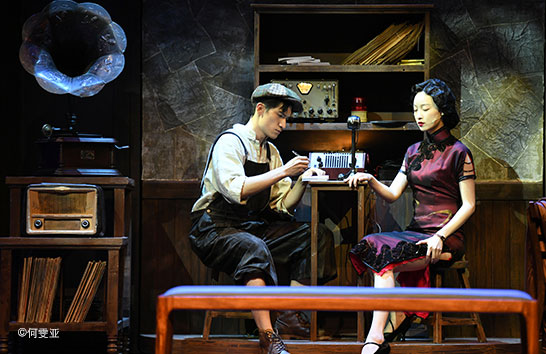
One One Zero Eight
Directed, written, and designed by Stan Lai
Performance Workshop & Theatre Above. China
Yet another terrific concoction from China’s preternaturally prolific playwright, Stan Lai—a mélange of contemporary dissatisfaction, historical tribute, and reincarnating time travel, mixed with mystery (who is she really?), suspense (will the secret operation be found out?), and high comedy (all this is too noisy for the neighbor!).
A popular novelist, Shu Tong, has moved into an old loft hoping for inspiration for her next book on espionage during Japan’s occupation of China (1937-45). She hit the jackpot: the building had begun as a weapons factory, and by 1943, while posing as the sculpture studio of artist Bai Shi, had actually been headquarters for the Chinese resistance. With her husband bonking his secretary, Shu Tong discovers that an old radio playing ‘40s music allows her to slip into the past, where she can commune with the sculptor, and where her life takes on a rich sense of purpose and connection.
Director-playwright Stan Lai deserves warm recognition for his ingenious set design, which plays a more active part in the play than is usual. The story unfolds in two eras, and finding out how we get from one to the other is one of the viewers’ many pleasures. On the one stage, we needed to see the upscale, modern living space with two levels—for working and sleeping—and in that same stage space, the 1940’s underground space, which also had to transform into the sculptor’s studio each time their resistance work was about to be discovered.
Adding to the pleasure, the admirable cast members played vastly different roles in the two time periods—yet another kind of “transformation”—first among them being the leads. Writer Shu Tong, played by popular star Ni Ni with flowing hair and gown, became Anna, the button-lipped spy in body-hugging cheongsam dress. Sculptor-spy Bai Shi, played by popular star Fan Guangyao with graceful, idealistic fervor, was also Zhuang, Shu Tong’s techie, lunky husband.
While following the suspenseful plot, and moving between historical eras, the matter of how the sets would get changed in time and how the actors would make their costume changes became another level of suspense. As a result, the audience was always responding on multiple levels—for example, to the double story as well as to its logistics. For some scenes, director Lai created a series of black borders that slid in front of the action into changeable configurations as different parts of the stage were needed, somewhat like adjusting a camera aperture, or cropping an image. In the underground scenes, when the false art studio set was needed for police inspection scenes, the espionage equipment vanished just how it was supposed to: behind a false wall, with a picture hung on it.
The show ended with just the right bang: ammunition going off; the over-the-top Japanese inspector bad guy revealed to be the Chinese undercover spy good guy (both by Hao Guang); the sure-to-die couple surviving inside a hollow copy of Rodin’s The Kiss; the lost found; time travel proven worthwhile; the undeserving husband getting the bush-league girl he deserved, and even the writer’s writer’s-block presumably unblocked. That’s what the theatre calls “a Wow Finish.”
In a festival that celebrates other kinds of contemporary productions, many of them “difficult” or offering the rewards of the “experimental,” this show offered snappy dialogue, sure design, and the reassuring certainty that, no matter how many plot twists there were, in the end all the pieces of the story were going to fit together perfectly. And they did.
*
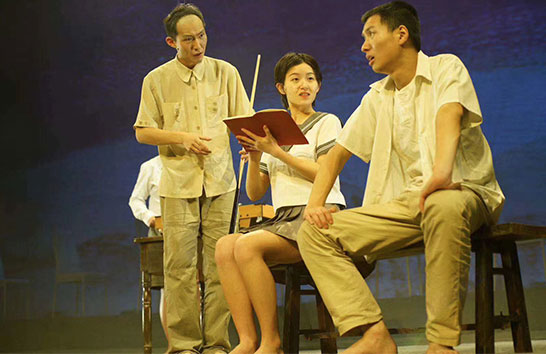
Red Sky
Written and with art direction by Stan Lai
Directed by Duan Fei
Nanjing University of the Arts, China
This production traveled a long road to Wuzhen. It originated in the work of Shireen Strooker (d. 2018), a celebrated Dutch-Indian actress-director-writer of theatre and film. In the 1970s and ‘80s, Strooker was part of an original Amsterdam theatre troupe, Het Werkteater, which specialized in group creation of plays through improvisation. Strooker took this approach in a workshop to U.C. Berkeley, where directing student Stan Lai (Lai Sheng-chuan) saw its potential for building a new dramatic canon for a new Taiwanese theatre. He wrote Red Sky on the 10th anniversary of the 1994 founding of his resulting Performance Workshop in Taipei, and its performance now also honors Strooker for her mentorship.
This Red Sky was a graduation project for acting students at the Nanjing University of the Arts (NUA), an arts institute with a history beginning in 1912, and evolving from the amalgamation of earlier art schools in Shanghai and Wuxi in 1959. It offers MFA degrees in music, fine art, film, design and more, as well as degrees in acting and directing through the School of Film and Television. Longtime actor Duan Fei, director of Red Sky, is head of the program, as well as of NUA’s new Stan Lai Institute.
The play takes place in a nursing home, and to prepare for it, the students visited nursing homes across the city of Nanjing. Rivalries, longings, illnesses, games, and dying—these were the stuff of life in the home, recognizably like every other “home” everywhere. My favorite moment was when two residents got together to play music, but one got crabby and they couldn’t agree on when the other one should come in. The audience was deeply affected by a scene in which a young man came to visit his parents in their room and hostilities exploded. There was a lovely scene in which a woman at the end of her own life gently talked her elderly beau through his death.
I gathered that for many who had seen a loved one falter and die, it wasn’t an easy show to watch.
Congratulations to the graduates of the program.
*
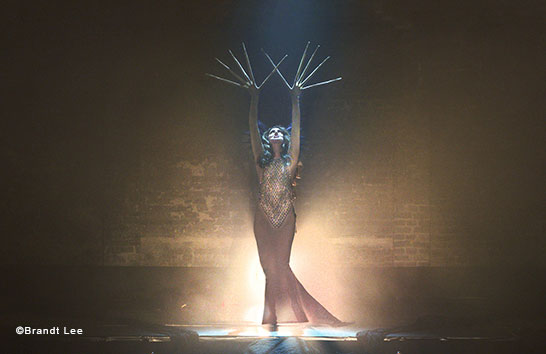
Rapture
Written and directed by Moira Finucane
Finucane & Smith Unlimited. Australia
What an unusual woman! An environmental scientist who has been to Antarctica, Finucane has special interests in the human impact on our planet, the relevant laws, and in the conservation of World Heritage sites.
Finucane began creating underground shows in the 1990s: “a mash-up of cabaret, fairy tale, museology, taxonomy, burlesque and archetype.” These shows have now appeared at major festivals in over a dozen countries, and won about a dozen awards for her unique form of art for climate action.
For her show, the entire room had been turned into a visual and sonic “lair,” floor to ceiling, with contributions by 30 Australian artists of various disciplines. Finucane performed along a raised, central walkway that divided the audience the length of the space. From up there, she embodied a range of beings from the amphibious to the beach bum, the primordial to the goth.
I wish I could say all this hung together. But in fact much of the show involved watching Finucane change costumes. She changed revealing outfits every few minutes for about an hour and a half, even going overtime. Rail thin, she first appeared in something so tight we might have seen her ribs, and after that she removed layer after impossibly thin layer until we knew where we were headed. I heard that she usually strips to nude, and I was glad she’d been told to stop just shy.
This played out against an indistinct soundscape—speaker problem?—and I couldn’t hear what she said although—or because?—she had a lot of volume (mic problem?). Surely her text had to do with the climate and its alarming effects. There was a kind of subplot, as it were, that involved her bitter story of a woman who was a marvelous performer who had been told she was nothing but an exhibitionist. It was hard to tell whether the irony was intended.
I admire anyone who puts on a show—always a tremendously complicated undertaking, and this one was certainly that. And it had so much going for it: an original, multi-disciplinary concept and a smart woman with a lot of chutzpah. Doesn’t it sound clever to use a little bump and grind to hook audiences apathetic about climate change?
But this was more like a harangue and a strip tease. As if Cher or Lady Gaga were agitating for an endangered penguin population, but couldn’t sing or dance.
*
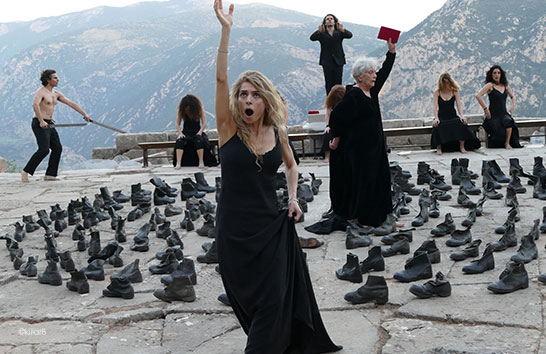
Trojan Woman
Written by Euripides
Directed by Theodoros Terzopoulos
Attis Theatre. Greece
This theatre company had the good fortune of performing in Wuzhen’s spectacular, amphitheatre-like Water Theatre, just right for Greek tragedy. Audiences sit on a low hillside, and watch the performances across water reflecting sky and trees, with the beautifully weathered walls of the town’s ancient buildings as the backdrop.
It is around the 12th century BCE and the Greeks have won the war. The Trojan men are dead. The Trojan queen and the young women of her family wait, suspended, for news: one of the queen’s daughters has been sacrificed; her baby grandson is about to be killed. They learn what each of their own fates will be—the queen, a slave; a princess, a concubine. The women of the queen’s family mourn. The chorus of ordinary women of Troy meet the same fates: wives, mothers, sisters, all enslaved. The women mourn and are taken away.
Trojan Women is considered one of the greatest anti-war plays ever written. It was first performed in 415 BCE, when Greece was at war and, in a separate conflict, had recently carried out a massacre and enslavement campaign. Through his description of the aftermath of the earlier Trojan War, Euripides’ Trojan Women implies a searing criticism of the barbarity of his own country’s conduct. For this reason, it is not surprising the play didn’t win first prize at the big drama competition that year.
Essentially a ritual, a performance of the play is nearly static. The elements you see in the photo remained throughout: the empty boots in concentric circles; a long bench for the chorus, gesturing oddly and grieving with their hair. News arrived, raised high, on white, red, or black cards (alive, wounded, dead). Already as we entered, a young man (Erdogan Kavaz) stood erect on a low wall at the back, speaking in a stunned, rapid-fire undertone that continued without pause for the duration of the show, reciting, recording, channeling. Hecuba at the center; the named women characters coming one by one to the fore, overflowing with their traumas.
Theatre like this is theatre at its best without the now-common intrusions of surging recorded music, video, or microphones taped to the actors’ faces. What was on stage was a product of human imagination and skills. Although there were a few vocal problems—most noticeably Hecuba’s—jet lag and the unfamiliar theatre might account for those, and I’d rather hear a tired human voice than an artificially amplified voice any day.
Over time, the waiting, receiving, and grieving took on the internal rhythm of shock and blasted despair that is recognizable to us today. Indeed, the director suggested connections between the catastrophic wars of then and now: black and white photos of the men lost in battle, and an air raid siren, as well as the boots and the country-neutral costumes. In a lovely directorial gesture that was lost in performance, the members of the chorus were themselves from warring and divided countries, such as Turkey, Israel, and Bosnia.
Neither the original text nor this production hinted that global reconciliation or peace is on the horizon.
*
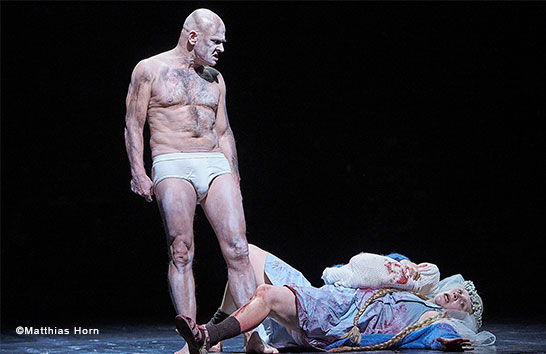
Caucasian Chalk Circle
Written by Bertolt Brecht
Directed by Michael Thalheimer
Berliner Ensemble. Germany
The illustrious Berliner Ensemble is known for its acting company, director Thalheimer started out as an actor, and this was an actors’ production. There was no set. The actors who were not in a scene sat visible at a long table upstage and watched the play from behind. Also onstage were an electric guitarist, up right, and a narrator, down left, suave in a suit that stayed white no matter what horrors ensued inches from him. Actors changed costumes and roles in full view. The scenes were played mostly downstage, and even on the front lip of the stage, so every moment of violence (inferred: rape but without touching; blood spilled but from a bucket), every drop of sweat or smear of fluids, every shudder of illness or terror landed virtually in our laps.
Brecht wrote his Caucasian Chalk Circle in 1944 in exile in the U.S. He based the play on Li Xingdao’s play, The Story of the Circle of Chalk, written in the 1300s. During the chaos of a coup, the Governor is killed, his wife flees, their poor maid, Grusha, finds herself with their infant. Over the next years, she risks her life to protect the child—through rape, starvation, a breakdown, homelessness, threats, a tricked marriage, abandonment by her fiancé, on and on. Years later, when the governor’s wife comes for the child for his inheritance, they end up in the court of the independent-minded judge Azdak, who breaks laws in favor of justice for the poor. In the Chinese version, after the pulling-on-the baby-in-the-circle sequence, the biological mother is granted custody of the child; in Brecht’s version, Azdak gives the child to Grusha, the one
who has made sacrifices and mothered him. But after the excitement of the ruling, Grusha was left onstage with the child, sitting alone…
None of the actors was less than superb. The clarity and versatility of their natural voices was a theatre-lover’s joy. Stefanie Reinsberger’s performance, eloquent in all Grusha’s ferocious determination and ambivalences, was a tour de force.
The visual style of the characters seems to have been at least inspired by the scathing caricatures of the artist George Grosz. Grosz and Brecht were contemporaries and friends as exiles among many exiled literary figures in America, and although they didn’t collaborate directly, many have noted the similarities in their affinity for the grotesque. Here, we had Grusha’s exaggeratedly long braids and large, shapeless sweater; the soldier-rapist’s skinhead and fuming stance; the governor’s wife’s silly, more-moneyed-than-thou look; the judge Azdak’s modified diaper, bare chest and fright wig—all describing a world as maddened by war as our own is, and as much in need of Grusha’s clumsy, instinctual love.
*
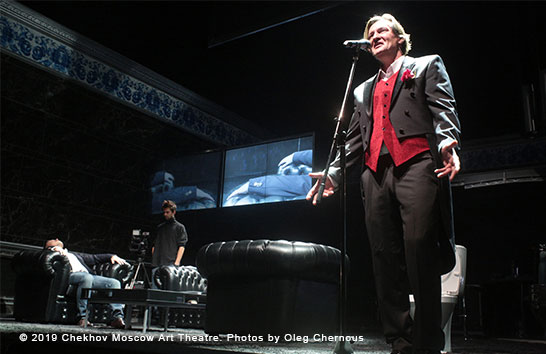
The Karamazovs
Based on the novel by Fyodor Dostoevsky
Directorial Creation of K. Bogomolov
Chekhov Moscow Art Theatre. Russia
This astonishing, five-hour production was partially a mash-up of elements classic and modern, heightened and pop, philosophical and lustful. As pointed out in the program notes—a courtesy rarely extended in programs anymore—Dostoevsky himself “packed metaphysics into the pulp fiction format, using the schemes of the tabloid novel…” To create the daring script, director Bogomolov hacked away at the original full-length novel (1880) and lifted out the compelling storyline of a father and his three acknowledged sons. In the process, Bogomolov retained some of the discourse Russian viewers expect from Dostoevsky—on ethics, free will, faith, and more—but he also turned some of the great novel on its head: a suicide by a religious seeker, gay sex, a tanning bed for the patriarch’s coffin, and a cemetery of toilets for gravestones.
Remarkably, out of this conglomeration rises a crystal-clear, razor-sharp thriller about a revenge murder and the search for the killer. Even the new title, which has dropped the word “brothers” from The Brothers Karamazov, suggests the name of a mafia-like family. Here, the hated head of the Karamazov family is brutally murdered, and suspicion falls on one of his sons, who is arrested, beaten within an inch of his life, “confesses” and goes to prison innocent while others around him, who know better, look on. Eventually, with the one brother already carrying the guilt, another brother is accused, but the accuser reveals that he is a fourth brother! He was the issue of the elder Karamazov’s rape of his mother, who was the village idiot—it is for her sake that he killed the paterfamilias. After a little blackmail, he will go unpunished. A terrific potboiler!
The set is an enormous black box, a metaphor, we read, for a Russian space too dark to see God in. Arrangements of black furniture organize the wide-open space into playing spaces suggesting different rooms: a corporate desk, a chesterfield sofa, a black leather set, a long conference table with an imposing chair at the head, a large armchair with a rhinoceros head on the back of it (a reference to Ionesco?). Add to these a functional bar-kitchen island center stage, accents in gleaming silver and black tile, and spoofing music from Russian pop and ballads to Freddie Mercury undercutting the action. The overall effect was an unsettling mix of posh moderne and old-boy network, decadent and dull; a swanky lounge, a man cave, a crypt and, I am advised, to a Chinese audience member, perhaps a KTV/karaoke room.
Sometimes two cameramen moved around the stage, as if they were filming a soap opera, documentary, or reality show of some kind. What they filmed was projected in real time onto large LCD monitors labeled “Left Eye” and “Right Eye.” This meant that we could view a scene live on stage or from different angles on the screens. As a result, we could linger up close on the actors’ magnificent performances, the beauty of the language spilling over us in waves and torrents. It also gave the sense that what was happening could be understood in more than way, that there was no single narrative. It also created a feeling of paranoia, of privacy boundaries dangerously breached.
The show premiered in Moscow in 2013 amid scandals, protests, resignations, reports of censorship and creative differences. But beyond titillating whispers none of it has persisted. Awards have been duly won, recognitions proffered, reputations confirmed, houses sold out, ovations showered, foreign invitations extended.
All deserved. The Karamazovs dignified the theatre, and elevated the rapt audience.
*
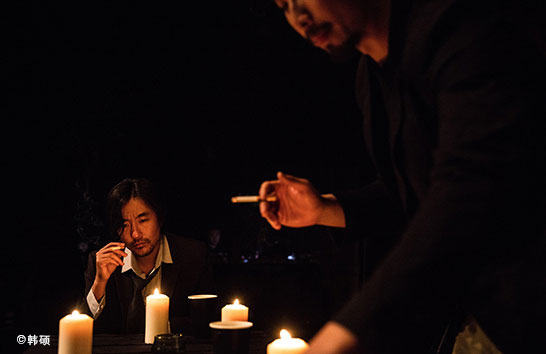
L'Étranger
Based on the novel by Albert Camus
Directed by Yang Ting
Yang Ting Drama Studio. China
On the last day, already with Closing Ceremony and packing on my mind, I got greedy and couldn’t resist running to see one last, brief-by-comparison show:
A French feeling: period music, hairstyles, cigarettes. Early scenes—about the death of Mersault’s mother, scene with friend in trouble, and reunion with an old lover—were played in front of a curtain. Couch, tables, chairs. Later, the curtain opened on a long, wide staircase that served for the shooting murder on the beach and the prison visits before the execution. Effective.
For no reason, Mersault stripped to his modish underpants, so the 20 minutes after that got lost. Very unfortunate.
There was an original 8mm projector showing footage with that familiar tick-tick-tick. Marvelous.
A young company making waves!
* * *
Many midnights, Festival-goers gather to read and listen. Photo by the author.
Cover Photo:
2019 Festival Closing Celebration
and Emerging Artists New Play Competition Awards Ceremony
Photo by the author.
Notes
All production photos can be found on the Festival website
www.wuzhenfestival.com
See my yearly Scene4 writings on the Wuzhen Theatre Festival since 2014 in the Archives
|